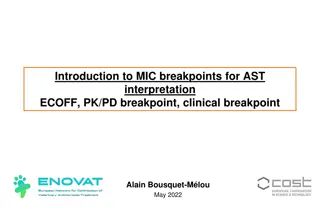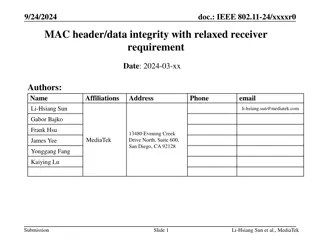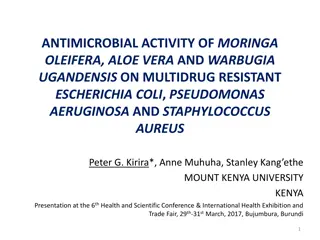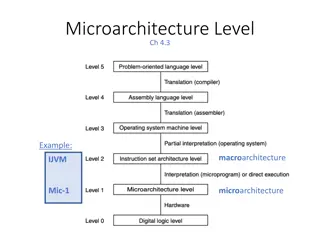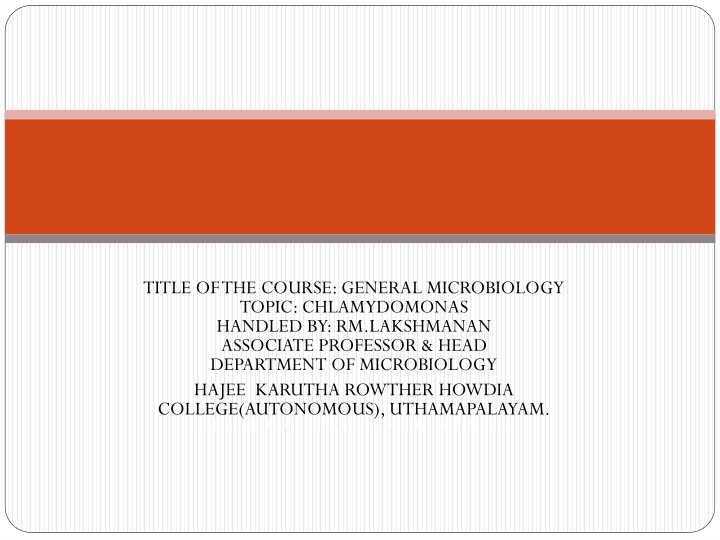
Chlamydomonas: Structure, Reproduction & Occurrence
Explore the intricate details of Chlamydomonas, a unicellular motile alga found in various environments. Learn about its structure, reproduction methods, and widespread occurrence. Discover the significance of its neuromotor apparatus in understanding this fascinating organism's behavior.
Download Presentation

Please find below an Image/Link to download the presentation.
The content on the website is provided AS IS for your information and personal use only. It may not be sold, licensed, or shared on other websites without obtaining consent from the author. If you encounter any issues during the download, it is possible that the publisher has removed the file from their server.
You are allowed to download the files provided on this website for personal or commercial use, subject to the condition that they are used lawfully. All files are the property of their respective owners.
The content on the website is provided AS IS for your information and personal use only. It may not be sold, licensed, or shared on other websites without obtaining consent from the author.
E N D
Presentation Transcript
TITLE OF THE COURSE: GENERAL MICROBIOLOGY TOPIC: CHLAMYDOMONAS HANDLED BY: RM.LAKSHMANAN ASSOCIATE PROFESSOR & HEAD DEPARTMENT OF MICROBIOLOGY HAJEE KARUTHA ROWTHER HOWDIA COLLEGE(AUTONOMOUS), UTHAMAPALAYAM. HAJEE KARUTHA ROWTHER COLLEGE, UTHAMAPALAYAM
STRUCTURE AND REPRODUCTION OF CHLAMYDOMONAS Contents Occurrence Structure Reproduction Asexual reproduction by formation of zoospores by formation of aplanospores palmella stage Sexual reproduction Isogamy Anisogamy Oogamy
Occurrence of Chlamydomonas: The genus Chlamydomonas (Gr. Chlamys, mantle; monas, single organism) includes about 500 species, found almost everywhere (i.e., ubiquitous). Commonly they are found in fresh water of lakes, ponds, tanks etc., but they are also available in brackish water (C. halophila), saline water (C. ehrenbergii), snow (C. nivalis) and some are also air borne.
Structure 1. The organism is an unicellular, motile alga. 2. The thallus is spherical to oblong in shape but some species are pyriform or ovoid. 3. The cell is somewhat pointed towards the anterior side and comparatively broader towards the posterior side. 4. The cell is surrounded by a cellulose cell wall which encloses the protoplasm. 5. The protoplasm consists of cytoplasm and a centrally located nucleus.
6.Two flagella are present on the anterior side of the cell. Both are of whiplash type. 7. At the base of each flagellum is present a basal granule or blepharoplast. 8. Both the flagella are equal in size and bigger than the size of the cell. 9. Below the basal granules are present two contractile vacuoles which are excretory in function. 10. Chloroplast is generally a cup-shaped structure in most of the species.
11. Each chloroplast encloses a single pyrenoid, which is the body of starch formation. 12. More than one pyrenoids are present in some species. 13. Many volutin granules are present in the cytoplasm. 14. An orange coloured eyespot or stigma is situated in the protoplasm at the anterior end of the cell. 15. The eyespot is supposed to be photoreceptive in function.
NeuromotorApparatus of Chlamydomonas: 1. It is also known as flagellar apparatus. 2. It consists of following: (i) Two blepharoplasts connected by a fibre called paradesmose (ii) One of the blepharoplasts remains connected to the centrosome of the nucleus by a descending thread called rhizoplast; (iii) Intranuclear or extranuclear centrosome is also connected with the nucleolus by a fibril.
REPRODUCTION IN REPRODUCTION IN CHLAMYDOMONAS: CHLAMYDOMONAS: Chlamydomonas reproduces both asexually and sexually: Asexual Reproduction: Asexual reproduction takes place commonly by the zoospore formation. But some others also reproduce by aplanospores and palmella stage. 1. Zoospores: During night with favorable environmental conditions zoospores are formed . At the starting of zoospore formation, the parent cell withdraws its flagella and takes rest. The contractile vacuoles disappear and the protoplast slightly withdraws from the cell wall. The protoplast then undergoes repeated longitudinal division at right angles to one another and forms generally 8 but rarely up to 64 units
Each unit of protoplast secretes a wall around and develops contractile vacuoles. They are released by rupturing or gelatinisation of the mother wall. At the time of liberations they develop their flagella. These flagellated daughter units are called zoospores. After liberation they behave as new individuals and capable of developing new crop of zoospores after 24 hours.
2. Aplanospores: The aplanospores are formed during unfavourable conditions. Following the same procedure like zoospore-formation, they develop 2-16 daughter protoplasts. Each one secretes, thin wall around, itself. These thin walled non-motile spores are called aplanospores. During favourable conditions aplanospore comes out of the mother cell and develops a new cell directly or its protoplast divides to form more zoospores.
3.Palmella Stage: During zoospore formation, suddenly if the environmental condition becomes unfavourable, the parent wall gets gelatinised. Consequently the daughter protoplasts also get gelatinised and undergo divisions. The entire structure becomes enlarged much more. This stage looks like another green alga Palmella of Tetrasporales and called this stage as Palmella stage During favourable conditions, the unit bodies develop into individual zoospore. Palmella stage is very common in C. kleinii and C. braunii.
Sexual Reproduction: Sexual reproduction takes place during desiccation or deficiency of nitrogenous compound in the growing medium. It takes place very commonly through isogamy and less frequently through anisogamy and oogamy.
1. Isogamy: Majority of the species are isogamous. In this type sexual union takes place between the morphologically identical gametes. In some species the vegetative cell directly develops into gametes (hologamy) or generally it divides into 8 to 64 gametes. The uniting gametes may develop from the same thallus (e.g., C. debaryanum) i.e., homothallic or from different thallus i.e., heterothallic (e.g., C. reinhardii and C. moewusii).
During union the flagella are found to be covered by agglutin (not found on the flagella of vegetative cell), a chemical substance (protein) which helps in the recognition of gametes of opposite mating type. In most of the species the gametes are unicellular, uninucleate, very small and biflagellate structures. During sexual union isogametes (+ and -) come very close to each other. The wall at the point of contact dissolves resulting in the formation of diploid quadriflagellate zygote through plasmogamy followed by karyogamy
2. Anisogamy: It is the union between two gametes (male and female) of different sizes. The larger one is called macrogamete (female) produced only 2 or 4 in the female gametangium. The smaller one is called microgamete (male) produced 8 or 16 in the male gametangium. The micro- gametes are more active than macrogametes. The microgamete comes very close to the macrogamete. Both the gametes undergo fusion and form zygote
3. Oogamy: It is the union between morphologically dissimilar gametes. The microgamete (male) is biflagellate and smaller in size than the macrogamete (female) which is non-motile and larger .n size. The male cell divides repeatedly and forms 16 units, each of which is converted into male gamete. On the other hand, the female cell leaves the flagella and directly functions as female gamete. The active male gamete comes very close to non-motile female gamete and attaches itself at the anterior end. Both the gametes undergo fusion and form zygote
Germination of Zygote: During germination the diploid nucleus (2n) of the zygote undergoes meiosis to form 4 or with additional mitosis forms 16 to 32 nuclei (n). The inner wall dissolves and by breaking the outer wall the haploid cells are liberated. During liberation they develop flagella and behave like new individuals.






